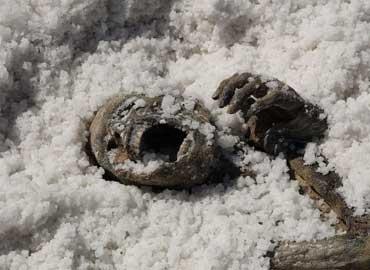
Under the Salt (Bajo la Sal) (Movie Review)
By this time most people have heard of the Narco-apocalypse that has been raging in Ciudad Juarez, Mexico for the last 20 years. The warring of the Juarez and Sinaloa drug cartels has pushed the murder rate to top of the world charts. A declaration of war on the cartels by Mexican president Felipe Calderon and the insertion of thousands of federal troops in Juarez actually served to push those numbers even higher for a time. What is more Calderon nearly fashioned his own Waterloo when he mistakenly dismissed a group of 16 young people gunned down at a birthday party as gang members. This is to say nothing of the region’s 20 year avalanche of vicious crimes against women that has taken the lives of nearly 1000 women and seen another 3000 go missing. It is real life horror and it is as profoundly annihilating as the world gets outside of an identified “war zone”. This Northern Mexican gendercide is without a doubt a partial inspiration for Mario Muñoz’s 2008 film “Bajo La Sal” (Under the Salt).
The film is set in the fictional city of Santa Rosa de la Sal. It is a middle class town developed around 100,000 acres of salt flats. As the story opens the severely decomposed body of a young girl is unearthed during a salt harvest. Soon after, embattled police commandate Trujillo arrives from afar and meets up with his former compatriot and local sheriff Salazar. Salazar fills Trujillo in on the investigation that includes not only the salt corpse but the disappearance and or murder of several other young girls in the area. Salazar is quick to try and reassure himself that this phenomenon is different from what is happening in Juarez. The clues are few and the list of suspects seemingly unlimited.
Victor Zepeda a morose local teen who helps his dad run the town’s only mortuary service attends the same school that the dead girls attended and has some fascinations that run toward the macabre. However his involvement in the case stays superficial until he meets Isabel, a local waitress who has a large stake in murders and perhaps all the keys to help catch the killer. Trujillo must battle his reemerging past and a veil of small town silence to unmask the murderer and prevent Isabel from being the next girl to go to a salty grave.
“Bajo la Sal” has a really fantastic opening sequence and one hell of a location in which to spin it’s gruesome yarn. It also features some really amusing, well-realized stop motion animation featuring Barbie and a killer Ken. Lush photography and a nice professional sheen to all the elements make it a film that would be easy to endorse if you are apt to get caught staring at the machinery and not troubling about the end product. The soundtrack and the production design are spot on for this kind of genre piece and the story works as a lite alternative to the over the top madness of Lucio Fulci’s “Don’t Torture a Duckling”. The problem is there is a dearth of soul to the whole affair.
The story ends where you’d expect to and the characters are clichéd in a way that never allows them to be more than place markers for the dramatic structure. It all seems like such a shame because the budget and location should have allowed for a much more haunting and resonant film. Instead the film’s unimaginative script and neutral dialog give the impression of a tale told on the fly. There’s an arbitrary quality to everyone’s character arc and the final showdown is telegraphed to such a degree that there’s very little tension around the fate of the good guys.
Perhaps an even bigger casualty of this rote, lethargic storytelling is the second act. It amounts to a straight highway with not so much as a single banked curve in the road to thrill the viewer. This middle segment of the film does give us a few clues that help Trujillo solve the case but the atmosphere is siphoned off during the exposition. Sacrificing feel for story might be fine had the story been more compelling and the sense of place and isolation not been the only consistent attributes that the film had going for it up to that point.
“Bajo la Sal” is not a bad film; in fact you might be fooled into believing it is a good one if it weren’t for the slower-than-drying-salt second act. But a story that draws inspiration from thousands of young women in Northern Mexico being ground to a pulp by the simultaneous rise of the maquiladoras and the proliferation of the drug trade should be devastating and unforgettable. Instead Mario Munoz’s movie is a familiar trip you don’t need to take with characters that you’ll forget by the next day.

